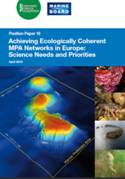A new European Marine Board Position Paper presents key scientific priorities for MPA management and calls for the rapid implementation of MPA networks in Europe.
Political drivers to halt the loss of marine biodiversity have led to an increase in Marine Protected Areas with global coverage estimated to be 8.3 million km2 in 2012 and rising (1). However, the establishment of MPAs in Europe has lagged behind terrestrial equivalents and has taken place in an ad hoc and largely uncoordinated way. In a new position paper, the European Marine Board presents ten scientific priorities for MPA management, calling for urgent action to inform, engage and empower stakeholders in planning connected networks of MPAs.
“MPAs are recognized as a key conservation tool and act as natural laboratories for research. We now need connected networks of MPAs that will lead to more resilient marine ecosystems ready to face pressures such as climate change and increasing human activities,” explains Dr. Niall McDonough, Executive Scientific Secretary of the European Marine Board.
The paper highlights connectivity between MPA reserves as an essential biodiversity management tool, promoting genetic diversity that improves the health and overall resilience of an ecosystem. MPA management in a changing world will also require adaptive approaches moving away from ‘static’ nature conservation to a new era of MPA design and implementation that can respond to ecosystem shifts or protect emerging biodiversity assets such as blue carbon – components of the marine ecosystem that sequester carbon such as seagrass.
The lead author of the paper, Dr. Esben Moland Olsen of the Institute of Marine Research (IMR), Norway, sums up a key message of the position paper: “New methods such as genetics are already enhancing our capacity to monitor and quantify marine ecosystems. We now need to establish a network of long-term monitoring programmes connected to MPA reserves that will provide key datasets to set baselines and monitor ecosystems at the species level.”
Integrated ocean observation will be crucial, both as a tool for scientific assessment and for achieving compliance in MPAs. Closer links with the maritime surveillance community are tipped as a tool to achieve successful enforcement of MPAs. This will become increasingly necessary as human activities e.g. fishing, shipping, continue to rise and exploitation of the oceans turn to remote high-sea areas where MPA legislation is often more complex and regulation much more difficult and costly.
Notes to editors
Marine Board Position Paper 18, Achieving Ecologically Coherent MPA Networks in Europe: Science Needs and Priorities, is available online at: www.marineboard.eu/publications-full-list
The position paper will be officially launched on 22 May 2013 at European Maritime Day 2013 in Valletta, Malta in a workshop on ‘Striking the right balance between marine protected areas and nautical tourism in the Mediterranean Sea.’
http://ec.europa.eu/maritimeaffairs/maritimeday/conference/programme_02_en.htm
The European Marine Board provides a pan‐European platform for its member organizations to develop common priorities, to advance marine research and to bridge the gap between science and policy, in order to meet future marine science challenges and opportunities.
The European Marine Board works in association with the European Science Foundation (ESF).
For more information, please contact the European Marine Board: Science Officer, Kate Larkin | klarkin@esf.org | Tel +32 (0) 476560841
